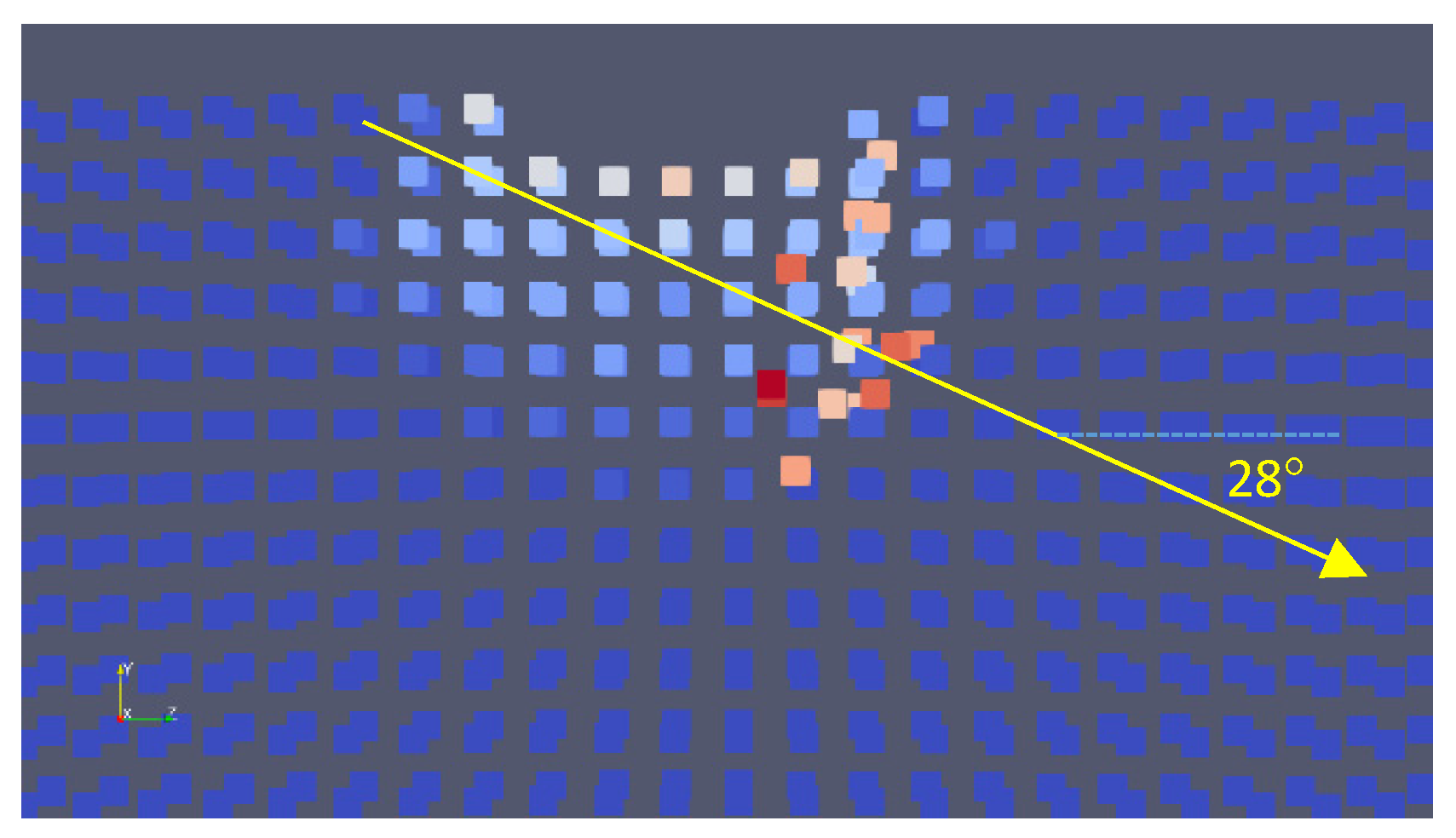Peridynamics Modelling of Rail Surface Defects in Urban Railway and Metro Systems †
Acknowledgments
References
- Kaewunruen, S. Identification and prioritization of rail squat defects in the field using rail magnetisation technology. Proc. SPIE Int. Soc. Opt. Eng. 2015, 9437, 94371H. [Google Scholar] [CrossRef]
- Kaewunruen, S. Discussion of “Field Test Performance of Noncontact Ultrasonic Rail Inspection System” by Stefano Mariani, Thompson Nguyen, Xuan Zhu, and Francesco Lanza di Scalea. J. Transp. Eng. Part A Syst. 2018, 144, 07018001. [Google Scholar] [CrossRef]
- Kaewunruen, S.; Ishida, M. Field monitoring of rail squats using 3D ultrasonic mapping technique. J. Can. Inst. Non-Destr. Eval. 2014, 35, 5–11. [Google Scholar]
- Kaewunruen, S.; Ishida, M. Rail squats: Understand its causes, severity, and non-destructive evaluation techniques. In Proceedings of the 20th National Convention on Civil Engineering, Pattaya, Thailand, 8–10 July 2015; Best Paper Award in Infrastructure Engineering. Available online: https://works.bepress.com/sakdirat_kaewunruen/56/ (accessed on 1 August 2017).
- Kaewunruen, S.; Ishida, M. In Situ Monitoring of Rail Squats in Three Dimensions Using Ultrasonic Technique. Exp. Tech. 2016, 40, 1179–1185. [Google Scholar] [CrossRef]
- Kaewunruen, S.; Remennikov, A.M. Dynamic Properties of Railway Track and Its Components: Recent Findings and Future Research Direction. Insight—Non-Destr. Test. Cond. Monit. 2010, 52, 20–22. [Google Scholar] [CrossRef]
- Kaewunruen, S.; Ishida, M.; Marich, S. Dynamic wheel-rail interaction over rail squat defects. Acoust. Aust. 2015, 43, 97–107. [Google Scholar] [CrossRef]
- Kaewunruen, S.; Remennikov, A.M. Current state of practice in railway track vibration isolation: An Australian overview. Aust. J. Civ. Eng. 2016, 14, 63–71. [Google Scholar] [CrossRef]
- Kaewunruen, S.; Remennikov, A.M. Sensitivity analysis of free vibration characteristics of an in situ railway concrete sleeper to variations of rail pad parameters. J. Sound Vib. 2006, 298, 453–461. [Google Scholar] [CrossRef]
- Kaewunruen, S.; Remennikov, A.M. Progressive failure of prestressed concrete sleepers under multiple high-intensity impact loads. Eng. Struct. 2009, 31, 2460–2473. [Google Scholar] [CrossRef]
- Kaewunruen, S.; Chiengson, C. Railway track inspection and maintenance priorities due to dynamic coupling effects of dipped rails and differential track settlements. Eng. Fail. Anal. 2018, 93, 157–171. [Google Scholar] [CrossRef]
- Remennikov, A.M.; Kaewunruen, S. A review of loading conditions for railway track structures due to train and track vertical interaction. Struct. Control Health Monit. 2008, 15, 207–234. [Google Scholar] [CrossRef]
- Silling, S.A. Reformulation of Elasticity Theory for Discontinuities and Long-Range Forces. J. Mech. Phys. Solids 2000, 48, 175–209. [Google Scholar] [CrossRef]
- Silling, S.A.; Askari, E. A Meshfree Method Based on the Peridynamic Model of Solid Mechanics. Comput. Struct. 2005, 83, 1526–1535. [Google Scholar] [CrossRef]
- Silling, S.A.; Epton, M.; Weckner, O.; Xu, J.; Askari, E. Peridynamic States and Constitutive Modeling. J. Elast. 2007, 88, 151–184. [Google Scholar] [CrossRef]
- Silling, S.A.; Lehoucq, R.B. Peridynamic Theory of Solid Mechanics. Adv. Appl. Mech. 2010, 44, 73–168. [Google Scholar]
- Silling, S.; Askari, A. Peridynamic Model for Fatigue Cracks SANDIA REPORT SAND2014-18590. Albuquerque 2014. Available online: http://docs.lib.purdue.edu/ses2014/mss/cfm/22/ (accessed on 1 August 2018).
- Kaewunruen, S.; Sussman, J.M.; Matsumoto, A. Grand challenges in transportation and transit systems. Front. Built Environ. 2016, 2, 4. [Google Scholar] [CrossRef]

Publisher’s Note: MDPI stays neutral with regard to jurisdictional claims in published maps and institutional affiliations. |
© 2018 by the authors. Licensee MDPI, Basel, Switzerland. This article is an open access article distributed under the terms and conditions of the Creative Commons Attribution (CC BY) license (https://creativecommons.org/licenses/by/4.0/).
Share and Cite
Freimanis, A.; Kaewunruen, S.; Ishida, M. Peridynamics Modelling of Rail Surface Defects in Urban Railway and Metro Systems. Proceedings 2018, 2, 1147. https://doi.org/10.3390/proceedings2161147
Freimanis A, Kaewunruen S, Ishida M. Peridynamics Modelling of Rail Surface Defects in Urban Railway and Metro Systems. Proceedings. 2018; 2(16):1147. https://doi.org/10.3390/proceedings2161147
Chicago/Turabian StyleFreimanis, Andris, Sakdirat Kaewunruen, and Makoto Ishida. 2018. "Peridynamics Modelling of Rail Surface Defects in Urban Railway and Metro Systems" Proceedings 2, no. 16: 1147. https://doi.org/10.3390/proceedings2161147





